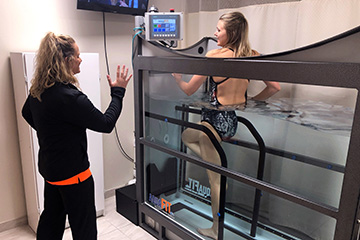How to Make Aquatic Therapy More Profitable for Your facility
Posted
Utilize these tips to improve reimbursements and keep therapists productive when providing aquatic therapy.
Aquatic therapy has proven beneficial in the treatment of many diagnoses ranging from generalized weakness to orthopedic surgeries and joint replacements to neurological conditions.
Reimbursement rates may vary, but Aquatic Therapy is a billable code. As is true with all treatments, thorough documentation helps to ensure full reimbursement from insurances.
For aquatic treatments, therapist documentation should include:
- • Why water is needed
- • Why a skilled therapist is needed
- • Plan to progress to land
- • Client feedback- pain level, ability to perform ADLs, activity tolerance
Objective Information to Include:
-
- • Water depth: Higher water depth = increased buoyancy and decreased weight bearing
- • Treatment progression:
-
- Jets on vs jets off- Exercising with the added resistance of jets shows progression in strength and balance/stability
- Time/Speed/Distance on treadmill- Increases in any, or all of these categories demonstrates patient progression
- Increased range of motion or manual muscle test score gives objective measurements of progress toward treatment goals and return to prior level of function
Concerned about productivity standards?
-
-
- • A therapist can only (ethically) bill for time spent with the patient (non-billable time is patient’s time spent changing in the locker room, walking to/from waiting area, etc.)
- • If patient receives OT and is working on ADLs, try to coordinate OT session for dressing in the locker room
- • Require patient to arrive 10-15 minutes early for sessions to compensate for dressing time
- • Point of Service Documentation- therapist can be productive while exercise chamber is filling and draining
- • Use time to complete subjective section of documentation- ask patient about pain levels, any limitations with ADLs and response to previous treatment
- • Review HEP
- • Begin stretching- patient can perform stretches while standing on treadmill belt or sitting on therapy bench
- • Complete documentation during session- with the therapist outside of the exercise chamber, most (if not all) documentation can be completed during treatment sessions keeping the therapist productive and on time for next appointments
- • Exercise chamber does not require extensive cleaning between treatment sessions- follow Ask Sam water care protocol below
-
By religiously following the Ask Sam water care protocol for the AquaFit underwater treadmill system, staff can stay productive, and your equipment will perform better for a longer period of time, helping to avoid increased time and money spent on equipment maintenance and upkeep.
How can a water care program help?
-
-
- Following the water care protocol will allow skilled therapists to spend time treating patients and spending less time cleaning and maintaining the equipment.
- Using Enzymes prolong filter life (keeping staff from frequently cleaning the cartridge filter) and help to keep the acrylic windows and door clear. It also prevents build up from water and body oils which cuts down on time spent wiping down the unit between patients.
-
What is the recommended protocol?
-
-
- At the end of the day check and log chemicals
- Shock the water in the storage tank
- Flood the system and run chlorinated water through the pipes into the exercise chamber
- After draining, use a shop vac to clear the remaining water out of the exercise chamber- be sure to lift the belt and remove any remaining water underneath
- Using the ProGienics Disinfectant Cleaner, wipe down the inside of the exercise chamber
-
For more info on AquaFit
Go to Resources for more info on Ask Sam




